
Lead Nurturing: A Step-By-Step Guide
Value is imperative in today’s B2B marketplace. Your product needs to address customers’ immediate—as well as their long-term needs. Current marketing practices take customer needs into consideration when producing content for lead generation programs. This same practice needs to be considered for B2B lead generation strategies.
Finding success with B2B lead nurturing in today’s market means profiling customers to identify the decision-maker. As well as, targeting your content marketing to the right buyer, at the right time. This is especially important because most executives don’t usually reveal their contact details, even to potential business partners.
Aside from using a variety of profiling techniques, marketers should also be creative in engaging and retaining the attention of prospects. These numbers prove that the power of context, and a personalized strategy in lead nurturing are beneficial for your business.
- 67 percent of B2B marketers saw around 10 percent increase in sales opportunities; 15 percent of these opportunities are increases of at least 30 percent.
- Nurtured leads offer an average of 20 percent growth in sales opportunities compared to non-nurtured ones.
- Lead nurturing emails have a response rate of four to 10 times compared to standard email blasts.
Build a Buyer’s Journey Map
Marketing can take you on a long hike. The one thing I can guarantee you about the journey is that getting more leads are not better if you don’t know how to nurture.
The goal of lead nurturing is to help potential customers on their buying journey. It’s not just about converting leads to becoming “marketing qualified.” It’s about helping them progress along the way to get more sales.
That said, I’ve seen companies spend most of their budget getting people to raise their hands but not putting enough toward progression.
I define lead nurturing as consistent and meaningful communication with viable potential customers regardless of their timing to buy.
It’s not “following up” every few months to find out if a prospect is “ready to buy yet.” Or doing random acts of nurturing. True nurturing involves a sometimes long and circuitous path, but along the way, you’ll be building long, meaningful and trust-filled relationships with the right people in targeted accounts.
Salespeople often struggle with developing nurturing content without marketing support.
If you’re wondering what kinds of content helps with progression, do this: Ask your sales team.
Start by asking your sales team questions like, “What’s the content you share with leads that seems to help the most?” or “What’s the content you use to help take people to the next level?”
The first step on that path to success is to start thinking like a customer.
Be the customer. Get out of your building and be as close as you can to their experience by actually observing the behaviors of your customer. After you’ve gained a solid understanding, build your customer journey map.
In sum, you will do the following:
Define the timeline of buying steps from the customers perspective
Take a “deep dive” into each step to answer the following:
- What are they doing? (buyer actions attending, reviewing analyst report, getting a demo, etc.)
- What are they thinking? (how do I get this done?)
- How are they feeling? Stressed out? Curious? Excited?

Three Stages of the Sales Funnel to Nurture Leads Through
Here’s the thing: Our customers don’t see our funnels. They only have the aggregate experience of what they see, hear, and feel from us. Yet, it’s helpful to notice that all customer buying cycles fit into three distinct funnel stages.
Let me explain.
- Top of the Funnel (TOFU): People at this stage are searching for ideas, tips, and resources to help them answer questions and get ideas for problems they’re facing. You’re attracting relevant visitors, but they are unknown. Your goal is to assist and provide enough value to get a conversion and move them from anonymous visitors to known people (i.e. name, company, email, etc.)
- Middle of the Funnel (MOFU): At this stage, people took some conversion step to express interest (subscribe, register, or download, etc.). You need to learn if this person and/or their company is a fit and their level of qualification. You also want to learn about their motivation. During this stage, you’ll share content to help progress them from interest towards purchase intent.
- Bottom of the Funnel (BOFU) – People are moving through a series micro-yeses and decisions on their journey. At this stage, you’re moving them from being a lead to a sales qualified opportunity. This is where the hand-off from marketing to sales takes place and where people ultimately make the buying decision.
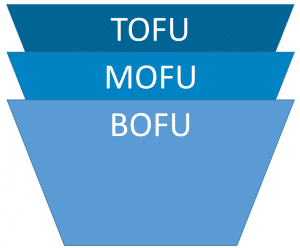
All three are part of an integrated lead generation funnel, and this article touches on each element while taking a closer look at lead nurturing.
Identify questions customers have at each stage of the journey
- How will this product or service help my company?
- Is this worth the hassle of trying to get my team on board to solve this problem? Why so?
- Will their solution work? Can they prove it?
- Is there another company out there that is better?
- Is the company credible?
- Can we afford it?
Help prospects find the answers to these questions, and you’ll remind them of the benefits of working with you. You’re creating value by giving them useful information in digestible, bite-sized chunks.
Read on for five lead nurturing tactics that will help you move people who’ve expressed interest into sales-qualified opportunities.
Plan your lead nurturing path with a focus on progression
Invest as much in forming creative and content for lead progression as you do for lead capture. I’ve seen companies spend most of their budget getting people to raise their hands but not enough toward progression.
The goal of lead nurturing is to help progress leads from initial interest toward purchase intent. It’s about progression.
It’s worth noting:
- The tactics employed and the frequency of touches will depend on the solutions you sell and the buying cycle of the prospect.
- You need to create different lead nurturing tracks based on demographic criteria, such as size, industry, role in the buying process and more.
Nurture customers with content
The effectiveness of nurturing depends upon the quality and type of content, as well as the pace and delivery of the content. In traditional marketing, the direct interests of the prospect aren’t always considered. However, modern marketing is changing to the point where brands know more about the leads and the specific content they’re looking for.
Thanks to the progression in marketing technology, the digital and social footprints left by leads on public channels like your website can now provide valuable insights. Analyzing and measuring their actions against a behavioral and demographic framework and updating the existing information in your marketing systems are crucial in nurturing the right context.
Top of the Funnel
Some tactics you can use at the TOFU phase are:
Establish yourself as a thought-leader who understands your buyers’ struggles, wants and needs
Think of nurturing as a strategically orchestrated dialog that begins with building trust. We’d all love for 100% of our audience to receive a single email from us and immediately score as a hot lead, ready to be passed to sales.
However, the reality is that buyers today are savvy and skeptical. They require multiple touches, but not the kind of product-focused touches most marketers build today. Buyers don’t want to hear how wonderful our product is. After all, isn’t everyone’s? We must build Engage stage content that appeals to their needs and establishes our brand as a thought leader, building trust over time.
Use a variety of channels to generate leads
Without lead generation, there are no leads to nurture, and I recommend a portfolio approach to lead generation involving at least three to four different lead types like the following:
- Online
- Events
- Inside sales/sales development
Don’t rely on just one primary lead source. The best marketers approach their work like a portfolio manager would run their mutual fund. Portfolio managers are always strategizing and testing, the optimal investment strategy. Think about it.
The following mind map shows some of the channels can use in your lead generation portfolio. 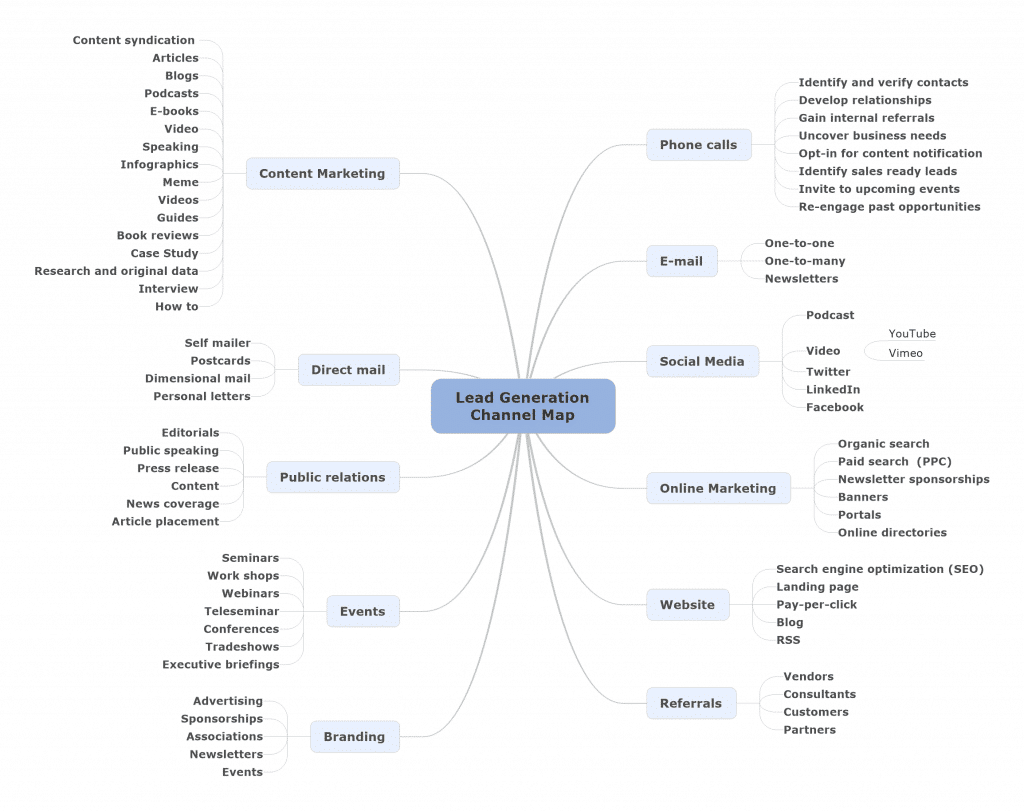
Identify what’s working right now in your lead generation portfolio and try new things. Switch channels in and out as you test. Your top of the funnel lead generation becomes a multi-touch process when you use more than one channel.
You’ll find one channel is good at starting a conversation while another might work better at advancing your discussion. You begin nurturing leads from the moment you say hello.
One last thing. Look at your budget for top of the funnel. Marketers allocate the largest chunk of their budget to TOFU (channels, content, and martech). I recommend you allocate about 20% to 40% to nurturing the leads you already have in the middle and bottom of your funnel.
Gather data about your buyer….one step at a time
We’ve all heard the saying, “Don’t propose marriage on a first date” by asking your prospects ten questions in your first communication or touch. Nurturing is the perfect opportunity to date your prospects and gather data gradually…before proposing marriage.
Build a progressive profiling strategy that captures the least threatening data you need first (i.e. name and email) and save the scary / heavy commitment questions like purchase time frame for later. Not only will nurturing allow you to capture the data you need for scoring, it will also allow you to tailor your content based on the answers and/or your buyers’ behavior in a well thought-out manner.
Create an opt-in email popup
Without contacts, there are no leads to nurture. If you’re an e-commerce site, an action that you can take to collect emails (aside from the less aggressive tactics like a first-time site visit or completing a purchase) is when a customer adds a product to their cart for the first time. It’s a simple action that shows the lead is interested in your product, with a significant chance of purchase.
Here, you could drive conversions by using a popup window that asks them to provide their email address to get a discount code for their first-ever purchase.
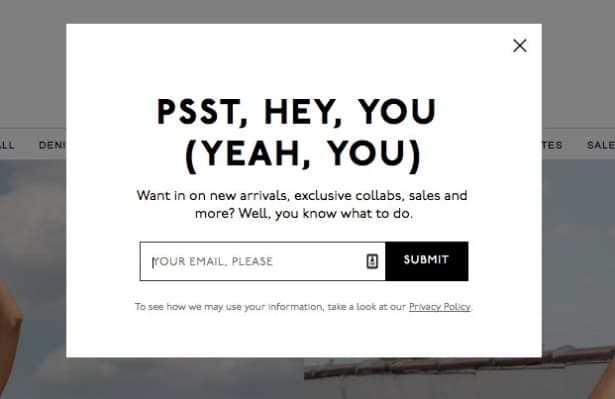
Middle of the Funnel
First, the easiest way to begin lead nurturing is to look at the contacts you already have in your databases. How can you advance the conversations one step further? Think of lead nurturing as an extension of the conversation you started with TOFU lead generation.
Look at the relationships you’ve started through the different lead generation sources and ask what content or information can be shared to advance that conversation.
Some tactics you can use at the BOFU phase are:
Enable sales during lead nurturing
Sales is an essential part of building your lead nurturing process. The ultimate goal of lead nurturing is to get more sales and advance more qualified opportunities into the pipeline.
You can invite sales to participate in the following ways:
- Get their perspective from talking with customers
- Ground test ideas for nurture messaging before you implement
- Share what they hear from clients and in the marketplace
If you’re wondering what kinds of content helps progress leads further faster, start by asking your sales questions like, “What’s the content you share with prospects that help them convert or move forward to the next step?”
The goal of lead nurturing is to help progress leads from initial interest toward purchase intent. It’s about progression. Sales people often struggle with developing nurturing content without support.
Here’s an example of involving Sales in the lead nurturing process.
Let’s say you just did a webinar or an online event. You can equip your sales development or inside sales team with a nurturing follow-up email template and content such as an executive summary or main takeaways from the webinar.
With that content, your sales team can call these leads and say, ‘I saw you attended our webinar last week, and we put together an executive summary and a two-page document with the main takeaways, what did you think of the event? Was it helpful? I like asking, “what motivated you to register or attend?” Why? Because when you understand their motivation, you can better help them.
Giving Sales this lead nurturing content provides them with a valid business reason to engage the prospect.
It’s about building relationships and adding value to people, even if they never buy from you. Empower your sales team to do nurturing. For more on this read, you can’t automate trust.
Keep your company/solution/product top-of-mind
Nurturing isn’t just about prospects. Don’t close a deal and then forget about your new customers you’ve worked so hard to gain. Continue to nurture your customers, not because you’re necessarily aiming for a certain lead score this time around, but because you want to keep your brand top-of-mind. Odds are these customers will be in the market for additional solutions or products that your company offers in the near future. Of course the flavor of communications as well as the frequency should be different for customers versus prospects.
Prevent non sales-ready leads from growing cold
Building what we call a “turnback” nurture program will prevent leads from falling into a black hole. A turnback strategy accounts for all the possible reasons a previously qualified lead turns out to be unqualified. It might be simply because they’re just not ready to buy. Maybe the prospect erroneously answered the progressive profiling questions. Or maybe he/she just doesn’t ever pick up the phone when a sales rep calls.
Think about all the reasons a sales rep wouldn’t want to waste their time following up on these leads and build your turnback program to do the follow-up. This can prevent the leads from becoming a total loss and often, drives real results in pipeline growth. Make sure the sales organization is clear on how to place leads into the proper turnback program once developed and establish criteria for what constitutes re-qualification. The results will be new sales-ready leads with minimum sales involvement.
Walk the path with your customer
In a complex sale, the journey can be long and challenging to help people move from initial interest to purchase intent.
Your only job is to make certain you nourish your customer along the way and guide them with a meaningful compass toward the right and best decision for their needs.
Think of your marketing team as trail guides who will need to point out all the sights along the way that are useful in the decision-making process.
Slow down, and walk at the customer’s pace, even if that means taking the long route with them when it comes to buying your service or product. If you hurry them along, you might end up with an exhausted customer who doesn’t feel good about the journey and won’t turn to you to continue the path to purchase.
Most economic buyers evaluate you based on: “How you sell me indicates how you will serve me.”
Here’s where that little statistic I mentioned earlier comes in. A study of business-to-business buyers shows that salespeople who become trusted advisors and understood the needs of economic buyers are 69% more likely to get away with a deal.
The complex sale requires that your prospect:
- Must be familiar with you and your company and with what you and your company do.
- Must perceive you and your company to be an expert in your field.
- Must believe that you and your business understand his or her specific issues and can solve them.
- Likes you and your company enough to want to work with you.
Remember you can’t automate trust. Trust-building should be the theme of your nurturing efforts.
Personalize web content
How your prospects’ respond to your marketing efforts offers valuable insights into how you can properly inject context in lead nurturing. One of the best ways to use behavioral data once its collected is to personalize your web copy and UX to individual prospects.
This pertains to making elements on your website visible to only a select few, depending on their behavior or action. Amazon uses this to redirect traffic when it detects that a person accessing the site is from a particular location. Instead of going to the U.S. site, users get directed to a unique homepage depending on where the visitor currently is.
Another possible application is having a predetermined series of generic campaigns with specific rules that make content visible to only a few categories of customers. For instance, showing ads to a customer for a product that they has viewed repeatedly over the last few days.
Repurpose content as needed
Reuse the content you already have — repurpose it and use it in a new way. The first step is to inventory existing content and think of a way to extend that material.
For example, a white paper can be broken into three to five articles that share a point of view.
This is a good strategy because I see more and more readers who would rather read short nuggets of information than longer. I heard a speaker use the term “Nugifying your content.”
If you are doing live events, record the event and convert that video into another content asset. Post snippets of material as well.
Looking at the earlier webinar example, the executive summary and key takeaways provided to Sales are examples of two additional pieces of content from one online event.
You are already creating content, you probably just don’t recognize it. So first, use what you have, catalog it and determine how you can bring new life to it. When you’ve leveraged what you already have, and have tracked it, then you can start finding gaps in current content areas.
Curate and leverage third-party content
Third-party content is another great source of material for lead nurturing, and they bring you an added credibility through the halo effect.
Research where your customers and clients are going for information. I would start by first asking your sales team what types of content publications your customers are currently reading, where are they going for information and what are the questions Sales is asking those customers.
Use online alerts to the main phrases in your industry to find content from bloggers and industry publications that are vendor agnostic and can share with your lead nurturing audience through a short synopsis and a link. For more ideas on content check out this post.
Follow-up on downloaded content or webinars
When a lead downloads content from your page, its best to email them in acknowledgment. This is a chance to offer other material that the leads may find useful, like a demo request or free trial. You can also ask them to share the content with friends or colleagues to increase campaign reach. Just make sure to include a CTA so the next action is clear.
Because the lead has shown interest in your content, you can also send them optimized drip emails that are equally educational to deliver value, build trust, and eventually convert. They become more aware of what solutions your organization can provide.
When it comes to webinars, you can record a thank you video to attendees a day after the webinar. If registrants failed to attend you can send an “on-demand” video to follow up. In addition, you can prompt a secondary conversion on the webinar to drive re-engagement.
Keep the touches coming
Most lead nurturing programs don’t begin to impact conversion before at least five meaningful touches. It’s important to continue nurturing leads whether it takes five touches or 25 touches to get them to the sales-ready point.
For example, if you have a nine-month sales cycle, you should nurture a lead in those nine months, and that’s at a minimum level. So that means nine nurturing patterns during that lead.
Bottom of the Funnel
The goal of lead nurturing is to convert leads into highly qualified opportunities and ultimately customers.
If that relationship were a baton, there is a point in time where both Marketing’s and Sales’ hands are on the baton, and you are making that introduction. Make sure you’re clear at what stage Marketing is going to hand the lead off so that Sales can run with it, and so that you don’t drop the baton or drop the relationship.
You can find this ideal point in the relationship by leveraging lead scoring and lead qualification, and I recommended this lead qualification occur through your inside sales, sales development, or tele-prospecting team. There is only so much information that you can get off a web form, or that someone will volunteer in an email.
Even if Marketing hands the lead to Sales once the prospect is ready to talk to a salesperson, it doesn’t mean that Marketing is done. What we are looking to do is help accelerate leads in the sales pipeline, and that is part of where we can work with the sales team to understand the key issues and problems that obstruct conversion. This is true full-funnel marketing.
Some tactics you can use at the BOFU phase are:
Personalize offers and discounts
Not all customers are of the same value to your business: someone who has bought a product every week should be more of a priority than those with a single purchase. The rule that might activate this email will depend on you for example; email discounts to a customer who has bought three times or more over the last three months.
Upsell and cross-sell
These techniques can improve your average order value. A classic up-selling strategy is showing similar products (often more expensive) when a customer views related product page. For buyers who tend to purchase several products in the same session, you can turn to cross-selling and show complementary products instead.
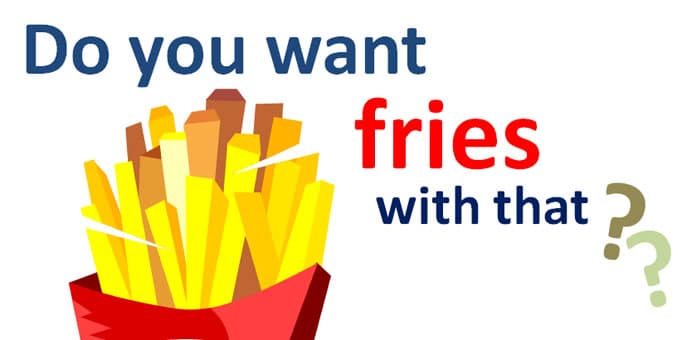
Email Marketing: The Mainstay of Lead Nurturing
Email marketing is easily the most prevalent and successful way to nurture prospects. So, it deserves special mention in this article.
However, you should learn to stay away from—or at least improve—the practice of email blasts or sending single email campaigns without follow-ups. From the definition alone, it’s clearly unwise to use such impersonal methods when you’re trying to engage with potential leads.
Here are two far more effective alternatives to email blasts:
Drip
Drip emails are time-based campaigns that help turn a blast into numerous follow-up touchpoints. It involves coming up with a logical sequence when sending out customized messages over a period or schedule, although each email doesn’t necessarily have to be directly related.
One challenge when implementing drip emails is that you have to make an educated guess about your customer’s behavior to know the “right” time to send it. Segmenting your list by demographic data, behavioral criteria based on buyer personas, or other categories created for a specific campaign can help contextualize the message.
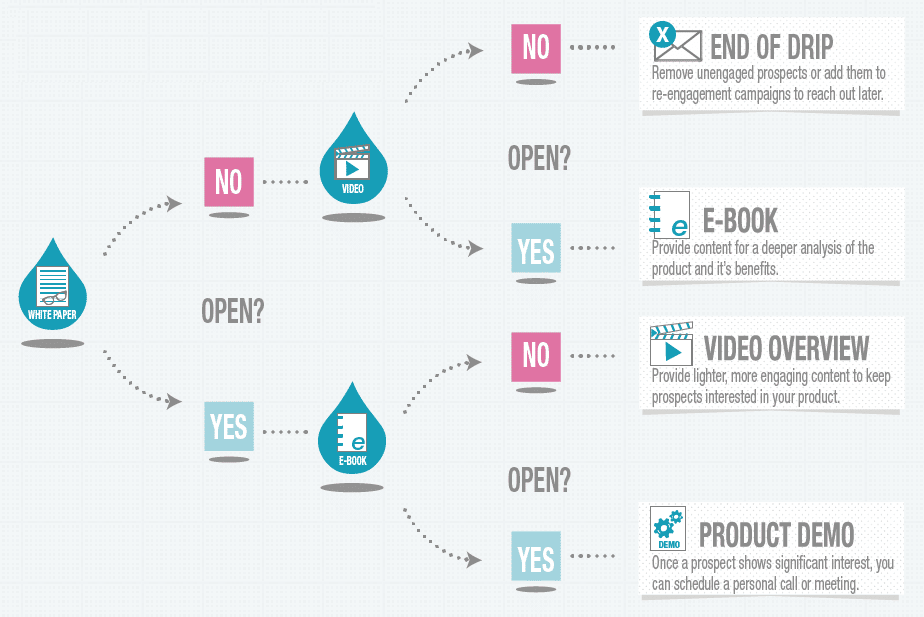
Source: https://www.pardot.com/blog/basics-drip-campaigns-infographic/
For instance, a bike retailer can send an invite to owners for a tune-up in January, then another one after two weeks offering discounts for a tune-up. This form of communication encourages action from the audience, educates them, and may help your brand stay top-of-mind.
Triggered
Also known as behavioral or nurture campaigns, email strategy involves executing personalized campaigns based on the recipient’s behavior. Specific behavior is preferred, like the number of times they’ve visited your website or the types of content they prefer to read.
Just about any behavior or action can be used as a trigger. You can implement contextual marketing when creating content, including finding the right schedule to email each prospect. This kind of campaign aims to offer educational value to help through the buying process, while encouraging engagement that enables you to nurture your relationships. Concluding this strategy to be the best option for conversion-focused campaigns.
Keep Walking the Journey
Startling as it may seem, recent research (and even studies from 20 years ago) shows that longer-term leads (future opportunities), often ignored by salespeople, represent almost 40 to 70% of potential sales. Research compiled by the MarketingSherpa Lead Generation Benchmark Report showed, “marketing departments with a lead nurturing campaign reported a 45% higher ROI than marketing departments that did not utilize a lead nurturing track.”
If inquiries are directly passed on to salespeople, reps, partners or distributors for follow-up, beware. You may be leaving as many as eight out of 10 sales prospects on the sales path for your competitors.
Now, get your compasses out and begin the long-yet-fruitful journey toward an effective lead nurturing program. You’ll be surprised how many potential customers will want to join you along the way.


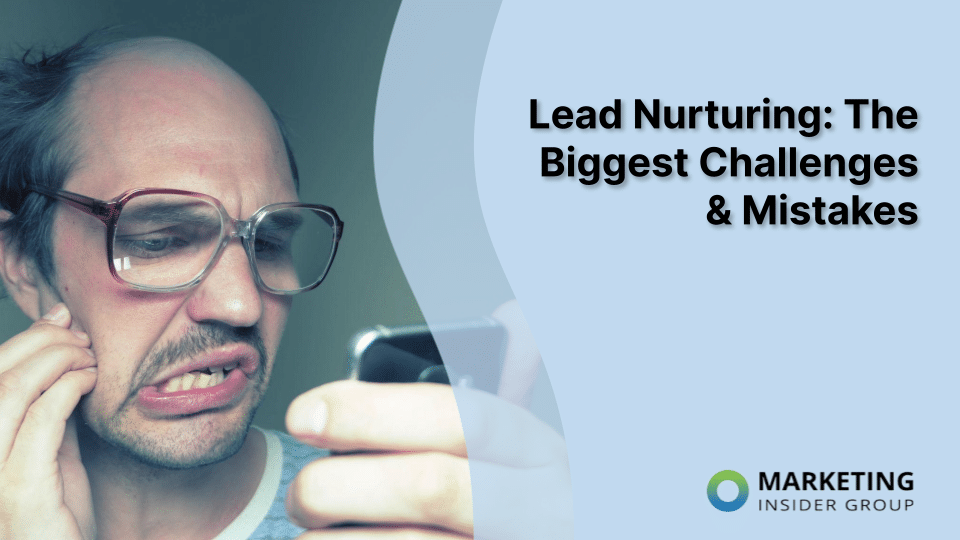





Excellent mix of information Anna. thank you
this is the “stuff” we would all benefit from if our sales team knew more about, or could even HALF-way keep up with what marketing teams are doing to help.